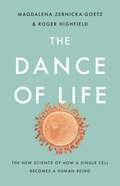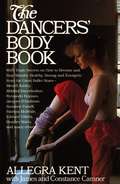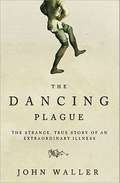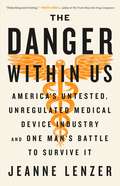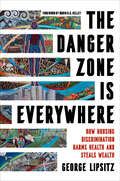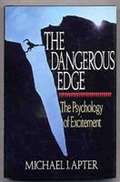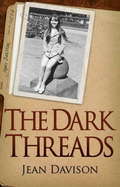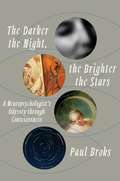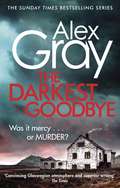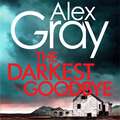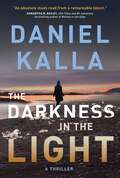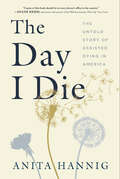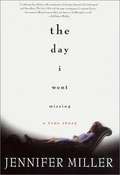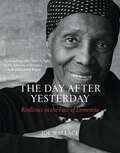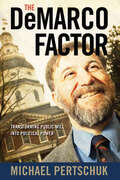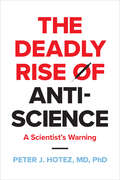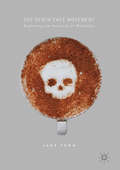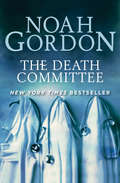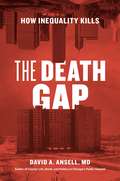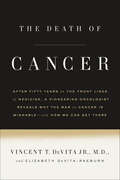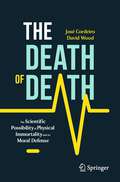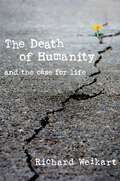- Table View
- List View
The Dance of Life: The New Science of How a Single Cell Becomes a Human Being
by Roger Highfield Magdalena Zernicka-GoetzA renowned biologist's cutting-edge and unconventional examination of human reproduction and embryo research Scientists have long struggled to make pregnancy easier, safer, and more successful. In The Dance of Life, developmental and stem-cell biologist Magdalena Zernicka-Goetz takes us to the front lines of efforts to understand the creation of a human life. She has spent two decades unraveling the mysteries of development, as a simple fertilized egg becomes a complex human being of forty trillion cells. Zernicka-Goetz's work is both incredibly practical and astonishingly vast: her groundbreaking experiments with mouse, human, and artificial embryo models give hope to how more women can sustain viable pregnancies. Set at the intersection of science's greatest powers and humanity's greatest concern, The Dance of Life is a revelatory account of the future of fertility -- and life itself.
The Dancers' Body Book: With Trade Secrets on How to Become and Stay Slender, Healthy, Strong and Energetic from the Great Ballet Stars
by Allegra Kent James Camner Constance CamnerBallet dancers have the strongest, most beautiful, probably the most envied bodies in the world. How do they stay slender and willowy while maintaining the extraordinary energy it takes to perform night after night? Can a nondancer or an amateur attain a dancer's figure and a dancer's vitality? And keep it?Here, in The Dancers' Body Book, the legendary ballerina Allegra Kent discloses the health, weight-watching, and relaxation secrets of some of the world's greatest ballet dancers -- from Suzanne Farrell and Fernando Bujones to Darci Kistler and Madame Alexandra Danilova. Combining them with two well-balanced diets -- one to lose weight by and one to live by -- and an exercise regimen that can be tailored to the individual, she provides a fabulous fitness program for everyone who longs to be slimmer, healthier, and more energetic.Fourteen varied menus incorporate delicious recipes from the dancers themselves (such as Jacques D'Amboise's Wonderful Dinner Salad and Dierdre Carberry's Almond Meringue Kisses), along with calorie guides and advice on how to create additional menus using your own favorite dishes. Helpful discussions on sports and exercise systems -- ranging from jogging and swimming to the sophisticated "Pilates" workout -- are also included, and in a special chapter entitled "A Healthy Outlook," the dancers talk candidly on such issues as smoking, anorexia, vitamins, doctors, massage, junk foods, fad diets, and injuries.Dancers take meticulous care of all their equipment because training and performance depend on it. Of course, the most essential piece of equipment, the body, needs the most care of all, and that is what this book is about: how to take care of the world's greatest machine.Allegra Kent joined the New York City Ballet at the age of fifteen and was a principal dancer with the company for thirty years, during which time she created a number of starring roles in ballets by Balanchine and Robbins. The mother of two daughters and a son, she is also the author of Allegra Kent's Water Beauty Book.
The Dancing Plague
by John WallerA gripping tale of one of history's most bizarre events, and what it reveals about the strange possibilities of human nature In the searing July heat of 1518, Frau Troffea stepped into the streets of Strasbourg and began to dance. Bathed in sweat, she continued to dance. Overcome with exhaustion, she stopped, and then resumed her solitary jig a few hours later. Over the next two months, roughly four hundred people succumbed to the same agonizing compulsion. At its peak, the epidemic claimed the lives of fifteen men, women, and children a day. Possibly 100 people danced to their deaths in one of the most bizarre and terrifying plagues in history. John Waller compellingly evokes the sights, sounds, and aromas; the diseases and hardships; the fervent supernaturalism and the desperate hedonism of the late medieval world. Based on new evidence, he explains why the plague occurred and how it came to an end. In doing so, he sheds light on the strangest capabilities of the human mind and on our own susceptibility to mass hysteria.
The Danger Within Us: America's Untested, Unregulated Medical Device Industry and One Man's Battle to Survive It
by Jeanne Lenzer"Before you get anything implanted in your body, read this book." - Shannon Brownlee, author of OvertreatedDid you know...- Medical interventions have become the third leading cause of death in America.- An estimated 10 percent of Americans are implanted with medical devices -- like pacemakers, artificial hips, cardiac stents, etc.- The overwhelming majority of high-risk implanted devices have never undergone a single clinical trial. In THE DANGER WITHIN US, award-winning journalist Jeanne Lenzer brings these horrifying statistics to life through the story of one working class man who, after his "cure" nearly kills him, ends up in a battle for justice against the medical establishment. His crusade leads Lenzer on a journey through the dark underbelly of the medical device industry, a fascinating and disturbing world that hasn't been written about before. What Lenzer exposes will shock readers: rampant corruption, elaborate cover-ups, shameless profiteering, and astonishing lack of oversight, all of which leads to dangerous devices (from artificial hips to pacemakers) going to market and into our bodies. In the vein of America's Bitter Pill and A Civil Action, THE DANGER WITHIN US is a stirring call for reform and a must-read for anyone who cares about the future of American healthcare. span
The Danger Zone Is Everywhere: How Housing Discrimination Harms Health and Steals Wealth (American Crossroads #73)
by George LipsitzCompellingly argues that good health is as much social as it is biological, and that the racial health gap and the racial wealth gap are mutually constitutive. The Danger Zone Is Everywhere shows that housing insecurity and the poor health associated with it are central components of an unjust, destructive, and deadly racial order. Housing discrimination is a civil and economic injustice, but it is also a menace to public health. With this book, George Lipsitz reveals how the injuries of housing discrimination are augmented by racial bias in home appraisals and tax assessments, by the disparate racialized effects of policing, sentencing, and parole, and by the ways in which algorithms in insurance and other spheres associate race with risk. But The Danger Zone Is Everywhere also highlights new practices emerging in health care and the law, emphasizing how grassroots community mobilizations are creating an active and engaged public sphere constituency promoting new forms of legislation, litigation, and organization for social justice.
The Dangerous Edge: The Psychology of Excitement
by Michael J. Aptera GREAT book on people's attraction to danger
The Dark Threads
by Jean DavisonTeenage life in the swinging sixties, hanging out in coffee bars talking fashion and pop music, who could wish for more? But in August 1968, growing pains started to kick hard for 18-year-old office worker Jean Davison and adolescent idealism quickly turns to angst and emptiness.With her home life in chaos, Jean turns to a psychiatrist hoping for a sensible adult to talk to. That’s where her problems really begin: a week’s voluntary psychiatric rest is the start of one long nightmare of drugs, electric shock treatment and abuse which turn her into a zombie.Losing five years of her young life to the mental health system, Jean finally finds the courage to say “no” to drugs and turns her life around, finds love and returns to the mental health service as a worker.Balancing quotes from case number 10826, her actual case notes which reveal a diagnosis of chronic schizophrenia, with her own account of interviews with doctors, this memoir raises disturbing questions on the treatment of psychiatric patients, which are still relevant todayJean Davison, was born in 1950 into a working class family in Yorkshire She left school at 15 to work in a factory. After leaving the psychiatric system she returned to education to study for GCEs. She has worked as a secretary for the NSPCC and within the health service. In 1979 she met Ian who she later married. She later graduated from university with a first-class degree in literature and psychology. Still living in Yorkshire with Ian, she now works in mental health. The Dark Threads is her first book.
The Dark Threads
by Jean DavisonTeenage life in the swinging sixties, hanging out in coffee bars talking fashion and pop music, who could wish for more? But in August 1968, growing pains started to kick hard for 18-year-old office worker Jean Davison and adolescent idealism quickly turns to angst and emptiness.With her home life in chaos, Jean turns to a psychiatrist hoping for a sensible adult to talk to. That’s where her problems really begin: a week’s voluntary psychiatric rest is the start of one long nightmare of drugs, electric shock treatment and abuse which turn her into a zombie.Losing five years of her young life to the mental health system, Jean finally finds the courage to say “no” to drugs and turns her life around, finds love and returns to the mental health service as a worker.Balancing quotes from case number 10826, her actual case notes which reveal a diagnosis of chronic schizophrenia, with her own account of interviews with doctors, this memoir raises disturbing questions on the treatment of psychiatric patients, which are still relevant todayJean Davison, was born in 1950 into a working class family in Yorkshire She left school at 15 to work in a factory. After leaving the psychiatric system she returned to education to study for GCEs. She has worked as a secretary for the NSPCC and within the health service. In 1979 she met Ian who she later married. She later graduated from university with a first-class degree in literature and psychology. Still living in Yorkshire with Ian, she now works in mental health. The Dark Threads is her first book.
The Darker the Night, the Brighter the Stars: A Neuropsychologist's Odyssey Through Consciousness
by Paul BroksWhen celebrated neuropsychologist Paul Broks's wife died of cancer, it sparked a journey of grief and reflection that traced a lifelong attempt to understand how the brain gives rise to the soul. The result of that journey is a gorgeous, evocative meditation on fate, death, consciousness, and what it means to be human. The Darker the Night, The Brighter the Stars weaves a scientist’s understanding of the mind – its logic, its nuance, how we think about what makes a person – with a poet’s approach to humanity, that crucial and ever-elusive why. It’s a story that unfolds through the centuries, along the path of humankind’s constant quest to discover what makes us human, and the answers that consistently slip out of our grasp. It’s modern medicine and psychology and ancient tales; history and myth combined; fiction and the stranger truth. But, most importantly, it’s Broks’ story, grounded in his own most fascinating cases as a clinician—patients with brain injuries that revealed something fundamental about the link between the raw stuff of our bodies and brains and the ineffable selves we take for who we are. Tracing a loose arc of loss, acceptance, and renewal, he unfolds striking, imaginative stories of everything from Schopenhauer to the Greek philosophers to jazz guitarist Pat Martino in order to sketch a multifaceted view of humanness that is as heartbreaking at it is affirming.
The Darkest Goodbye: Book 13 in the Sunday Times bestselling detective series (DSI William Lorimer #13)
by Alex Gray***Discover your next reading obsession with Alex Gray's bestselling Scottish detective series*** Whether you've read them all or whether this is your first Lorimer novel, THE DARKEST GOODBYE is perfect if you love Ian Rankin, Val McDermid and Ann Cleeves Don't miss the latest thrilling series instalment - BEFORE THE STORM IS OUT NOW WHAT THEY'RE SAYING ABOUT THE LORIMER SERIES:'Warm-hearted, atmospheric' ANN CLEEVES'Relentless and intriguing' PETER MAY'Move over Rebus' DAILY MAIL'Exciting, pacey, authentic' ANGELA MARSONS'Superior writing' THE TIMES'Immensely exciting and atmospheric' ALEXANDER MCCALL SMITH_______________ Was it mercy? Or murder? When newly fledged DC Kirsty Wilson is called to the house of an elderly woman, what appears to be a death by natural causes soon takes a sinister turn when it is revealed that the woman had a mysterious visitor in the early hours of that morning - someone dressed as a community nurse, but with much darker intentions.As Kirsty is called to another murder - this one the brutal execution of a well-known Glasgow drug dealer - she finds herself pulled into a complex case involving vulnerable people and a sinister service that offers them and their loved ones a 'release'.Detective Superintendent William Lorimer is called in to help DC Wilson investigate and as the body count rises, the pair soon realise that this case is about to get more personal than either of them could have imagined . . . Alex Gray's new novel BEFORE THE STORM is available to pre-order now _______________ ***PRAISE FOR ALEX GRAY*** 'Convincing Glaswegian atmosphere and superior writing' The Times 'Brings Glasgow to life in the same way Rankin evokes Edinburgh' Daily Mail 'Exciting, pacy, authentic' Angela Marsons 'Sums up everything that is golden and enthralling about a good book' Fully Booked
The Darkest Goodbye: Book 13 in the Sunday Times bestselling detective series (DSI William Lorimer #13)
by Alex GrayWhen an elderly woman is found dead at her home, newly fledged DC Kirsty Wilson is called to the scene. It appears that the woman had a mysterious visitor in the early hours of that morning - someone dressed as a carer, but with much darker intentions. It soon becomes obvious that this was not death by natural causes, in fact, it was murder. Before she can catch her breath, DC Wilson is thrown in at the deep end as another body turns up - this time it's a gruesome crime scene, the victim a well-known drug dealer from Glasgow's mean streets, and there's no question that this was a brutal execution. The two cases appear to have nothing in common, but when a second vulnerable person is murdered in their sleep, the police realise that it's only a matter of time before the next victim emerges and Detective Superintendent William Lorimer is called in to help DC Wilson investigate. This case is big and it's about to get more personal than either of them could have imagined...
The Darkest Goodbye: Book 13 in the million-copy bestselling detective series (William Lorimer Ser. #16)
by Alex Gray***THE MILLION-COPY BESTSELLING DETECTIVE SERIES*** 'One of the best is Alex Gray' Literary Review 'Intensely exciting and atmospheric' Alexander McCall Smith 'Move over Rebus' Daily Mirror Was it mercy? Or murder? _______________ When newly fledged DC Kirsty Wilson is called to the house of an elderly woman, what appears to be a death by natural causes soon takes a sinister turn when it is revealed that the woman had a mysterious visitor in the early hours of that morning - someone dressed as a community nurse, but with much darker intentions.As Kirsty is called to another murder - this one the brutal execution of a well-known Glasgow drug dealer - she finds herself pulled into a complex case involving vulnerable people and a sinister service that offers them and their loved ones a 'release'.Detective Superintendent William Lorimer is called in to help DC Wilson investigate and as the body count rises, the pair soon realise that this case is about to get more personal than either of them could have imagined . . .Whether you've read them all, or whether you're coming to Alex Gray's highly acclaimed Lorimer series for the very first time, this is the perfect, page-turning winter read if you love Ann Cleeves, Val McDermid or Ian Rankin. _______________ ***PRAISE FOR ALEX GRAY*** 'Convincing Glaswegian atmosphere and superior writing' The Times 'Brings Glasgow to life in the same way Rankin evokes Edinburgh' Daily Mail 'Exciting, pacy, authentic' Angela Marsons 'Sums up everything that is golden and enthralling about a good book' Fully Booked
The Darkness in the Light: A Thriller
by Daniel KallaA psychiatrist&’s patients are dying—are they suicides related to a new antidepressant, or is there something even more sinister going on in the northernmost town in the US? A riveting new thriller from internationally bestselling author Daniel Kalla.After Brianna O&’Brien takes her own life, Dr. David Spears blames himself. Though he understands suicides can be a tragic occurrence in psychiatric practice, this loss hits him particularly hard. With Brianna, he&’s convinced he missed crucial warning signs. When David suspects Brianna&’s friend, Amka Obed—whom he&’s also been treating virtually—is in crisis, he flies to the remote Arctic community of Utqiagvik, Alaska, only to discover that she has disappeared. While the regional police are confident that Amka will turn up safe, David and the town&’s social worker, Taylor Holmes, have serious doubts. Each battling their own demons, David and Taylor launch an investigation, determined to help uncover the truth about what happened to Amka. David wonders if a new antidepressant he recently prescribed both Amka and Brianna played a role in what took place. Taylor, who&’s familiar with the locals, suspects a drug lord with connections to Amka&’s boyfriend. Who is right? Where is Amka? Is she still alive? What begins as a missing persons inquiry and suspicion over a pharmaceutical cover-up quickly evolves into a terrifying journey of treachery and death—one that will horrify this isolated town and endanger many more lives.
The Day I Die: The Untold Story of Assisted Dying in America
by Anita HannigAn intimate investigation of assisted dying in America and what it means to determine the end of our lives.In this groundbreaking book, award-winning cultural anthropologist Anita Hannig brings us into the lives of ordinary Americans who go to extraordinary lengths to set the terms of their own death. Faced with a terminal diagnosis and unbearable suffering, they decide to seek medical assistance in dying—a legal option now available to one in five Americans.Drawing on five years of research on the frontlines of assisted dying, Hannig unearths the uniquely personal narratives masked by a polarized national debate. Among them are Ken, an irreverent ninety-year-old blues musician who invites his family to his death, dons his best clothes, and goes out singing; Derianna, a retired nurse and midwife who treks through Oregon and Washington to guide dying patients across life's threshold; and Bruce, a scrappy activist with Parkinson's disease who fights to expand access to the law, not knowing he would soon, in an unexpected twist of fate, become eligible himself.Lyrical and lucid, sensitive but never sentimental, The Day I Die tackles one of the most urgent social issues of our time: how to restore dignity and meaning to the dying process in the age of high-tech medicine. Meticulously researched and compassionately rendered, the book exposes the tight legal restrictions, frustrating barriers to access, and corrosive cultural stigma that can undermine someone's quest for an assisted death—and why they persist in achieving the departure they desire.The Day I Die will transform the way we think about agency and closure in the face of death. Its colorful characters remind us what we all stand to gain when we confront the hard—and yet ultimately liberating—truth of our mortality.
The Day I Went Missing: A True Story
by Jennifer MillerIt's happened to all of us at one time: falling victim to someone who says the words we want to hear. It usually ends with a wounded heart or lost love. But in one woman's case, it took a deadly turn. Jennifer Miller, an Emmy-nominated TV writer, was a highly functioning member of the Hollywood scene who had everything going for her: great contacts, great work, and the promise of an even greater future. But what Jennifer did not have was a happy life, or even the ability to understand what happy meant. A single woman who did not know what it was like to have a love relationship, she was haunted by a deepening despair. She toyed with therapy, but Jennifer, the daughter of a shrink, was convinced that she was beyond help. Then she met Dr. David Cohen, and discovered something worse than depression. Believing she had finally found someone to trust completely, Jennifer allowed herself to get sucked into Dr. Cohen's world. What followed is a chilling tale of fraudulent therapy that is enthralling and horrifying from its skillful beginning to its shocking conclusion.
The Day after Yesterday: Resilience in the Face of Dementia
by Joe WallaceA deft combination of narrative and portraiture that breaks the taboo around dementia, replacing the fear and futility with empathy and nuance.A graphic designer, a writer, a public servant, a retired PhD, a 29-year-old with early-onset Alzheimer&’s. These are just some of the 50 million people living with dementia who share their deeply personal stories with Joe Wallace in The Day after Yesterday, a powerful collection of portraits and personal stories that humanizes the millions of people living with the disease. Each story in this poignant volume offers a unique and powerful lesson—not just about how to live with a terminal illness, but how to do so with resilience and dignity.Dementia is often a taboo subject with limited public awareness or discourse. A diagnosis can become a mechanism for segregating those affected from society, making it easier to see only the label and not the individual, which, in turn, makes it easier to ignore the burgeoning health crisis and the individuals themselves. But as one man told Wallace, &“Don&’t believe the narrative that life is over. I want my voice to help get people to treat us the same as they did before we got the diagnosis. We may change some, but we are the same people!&” More than a visual representation, The Day after Yesterday&’s compassionate portraits capture the dignity and richness of each individual, destigmatizing dementia and enabling a loving, respectful, and much-needed conversation.
The DeMarco Factor: Transforming Public Will into Political Power
by Michael PertschukVinny DeMarco might be a latter-day Don Quixote except that he tilts his lance at real obstacles to social justice: lobby-locked state legislatures and Congress, stonewalling the public will. And he makes impossible dreams come true. In twenty years of organizing campaigns in Maryland, he has led successful efforts to pass gun control laws (against National Rifle Association opposition), to hike cigarette taxes to prevent youth smoking, and to extend health care to hundreds of thousands of low-income workers. He has also built a unique alliance of mainstream and conservative faith groups, which helped secure rare bipartisan votes in Congress for the enactment in July 2009 of landmark FDA regulation of tobacco manufacture and marketing.DeMarco's unique strategic template, developed over two decades of serial campaigning, includes momentum-building stages over a multiyear campaign; unrelenting, skillful access to the media for engaging public support; coalitions of hundreds, even thousands, of faith, community, labor, public health, and business groups; and a hard press on candidates to support legislation before elections, rather than after they are comfortably in office. As an organizer/leader, Demarco also succeeds in his campaigns through force of personality: his unquenchable exuberance and idiosyncrasies delight and madden his opponents--sometimes his allies, too.Michael Pertschuk, himself a veteran advocate, here chronicles three of DeMarco's campaigns, each facing a different obstacle course. His deep analysis draws out strategic and leadership lessons that engaged citizens and advocates for popular causes stonewalled by powerful lobbies can put to immediate and practical use.
The Death Café Movement: Exploring the Horizons of Mortality
by Jack FongThis sociological work examines the phenomenon of the Death Café, a regular gathering of strangers from all walks of life who engage in “death talk” over coffee, tea, and desserts. Using insightful theoretical frameworks, Fong explores the common themes that constitute a “death identity” and reveals how Café attendees are inspired to live in light of death because of death. Fong examines how the participants’ embrace of self-sovereignty and confrontation of mortality revive their awareness of and appreciation for shared humanity. While divisive identity politics continue to foster neo-tribalisms and the construction of myriad “others,” Fong makes visible how those who participate in Death Cafés end up building community while being inspired toward living more fulfilling lives. Through death talk unfettered from systemic control, they end up feeling more agency over their own lived lives as well as being more conscious of the possibility of a good death. According to Fong, participants in this phenomenon offer us a sublime way to confront the facticity of our own demise—by gathering as one.
The Death Committee
by Noah GordonAt Suffolk County General Hospital, three brilliant young men are brought together by their ambition and passionate dedication to life. But they work in the shadow of the Death Committee, a formidable hospital tribunal where doctors sit in judgment of their peers, deciding who is to blame when a death could have been prevented. During an unforgettable year of love and fear, failure and victory, the young doctors must face the crucial dramas and triumphs of hospital life.
The Death Committee
by Noah GordonThe New York Times–bestselling author delivers &“a big, authentic novel&” of the professional and personal challenges of three young doctors (The New York Times).Three young men from different backgrounds have graduated from medical schools and become surgical fellows at a leading teaching hospital in Boston. They learn to become surgeons, to communicate with patients and families, and to be observed and appraised by their peers and professors on daily rounds. And each month—sometimes with dry mouth and rapid pulse—each attends the meeting of the Mortality Conference, known to all as the Death Committee, which examines every patient loss for possible human error, in order to prevent it from happening again. How the Death Committee affects and is affected by the lives, loves, and ambitions of three new doctors is the theme of this intriguing and profoundly moving novel.
The Death Gap: How Inequality Kills
by David A. AnsellWe hear plenty about the widening income gap between the rich and the poor in America and about the expanding distance separating the haves and the have-nots. But when detailing the many things that the poor have not, we often overlook the most critical—their health. The poor die sooner. Blacks die sooner. And poor urban blacks die sooner than almost all other Americans. In nearly four decades as a doctor at hospitals serving some of the poorest communities in Chicago, David Ansell has witnessed firsthand the lives behind these devastating statistics. In The Death Gap, he gives a grim survey of these realities, drawn from observations and stories of his patients. While the contrasts and disparities among Chicago’s communities are particularly stark, the death gap is truly a nationwide epidemic—as Ansell shows, there is a thirty-five-year difference in life expectancy between the healthiest and wealthiest and the poorest and sickest American neighborhoods. If you are poor, where you live in America can dictate when you die. It doesn’t need to be this way; such divisions are not inevitable. Ansell calls out the social and cultural arguments that have been raised as ways of explaining or excusing these gaps, and he lays bare the structural violence—the racism, economic exploitation, and discrimination—that is really to blame. Inequality is a disease, Ansell argues, and we need to treat and eradicate it as we would any major illness. To do so, he outlines a vision that will provide the foundation for a healthier nation—for all. Inequality is all around us, and often the distance between high and low life expectancy can be a matter of just a few blocks. But geography need not be destiny, urges Ansell. In The Death Gap he shows us how we can face this national health crisis head-on and take action against the circumstances that rob people of their dignity and their lives.
The Death of Cancer
by Elizabeth DeVita-Raeburn Vincent T. DeVita Jr.Cancer touches everybody’s life in one way or another. But most of us know very little about how the disease works, why we treat it the way we do, and the personalities whose dedication got us where we are today. For fifty years, Dr. Vincent T. DeVita Jr. has been one of those key players: he has held just about every major position in the field, and he developed the first successful chemotherapy treatment for Hodgkin’s lymphoma, a breakthrough the American Society of Clinical Oncologists has called the top research advance in half a century of chemotherapy. As one of oncology’s leading figures, DeVita knows what cancer looks like from the lab bench and the bedside. The Death of Cancer is his illuminating and deeply personal look at the science and the history of one of the world’s most formidable diseases. In DeVita’s hands, even the most complex medical concepts are comprehensible.Cowritten with DeVita’s daughter, the science writer Elizabeth DeVita-Raeburn, The Death of Cancer is also a personal tale about the false starts and major breakthroughs, the strong-willed oncologists who clashed with conservative administrators (and one another), and the courageous patients whose willingness to test cutting-edge research helped those oncologists find potential treatments. An emotionally compelling and informative read, TheDeath of Cancer is also a call to arms. DeVita believes that we’re well on our way to curing cancer but that there are things we need to change in order to get there. Mortality rates are declining, but America’s cancer patients are still being shortchanged—by timid doctors, by misguided national agendas, by compromised bureaucracies, and by a lack of access to information about the strengths and weaknesses of the nation’s cancer centers.With historical depth and authenticity, DeVita reveals the true story of the fight against cancer. The Death of Cancer is an ambitious, vital book about a life-and-death subject that touches us all.
The Death of Death: The Scientific Possibility of Physical Immortality and its Moral Defense (Copernicus Books)
by David Wood José CordeiroIs death inevitable? Until now, the history of mankind has been marked by this fatal fact. Religions, borders and progress are born from an ancient fear of death, comfort from this fear man often found only in religious paradigms. But according to José Luis Cordeiro and David Wood, the incontrovertible fact of death is no longer an absolute certainty - science and technology are preparing to tear down the final frontier: that of immortality.This accessible book provides insight into recent exponential advances in artificial intelligence, tissue regeneration, stem cell treatment, organ printing, cryopreservation, and genetic therapies that, for the first time in human history, offer a realistic chance to solve the problem of the aging of the human body. In this book, Cordeiro and Wood not only present all the major developments, initiatives, and ideas for eternal life, they also show why there are a number of good arguments for seeing death for what it is: the last undefeated disease.Enter any drugstore or bookstore, and we confronted with a mountain of nonsense concerning the aging process. Society seems obsessed with aging. That is why The Death of Death is such a refreshing delight, able to cut through the hype and reveal a balanced, authoritative, and lucid discussion of this controversial topic. It summarizes the astonishing breakthroughs made recently in revealing how science may one day conquer the aging process.Michio Kaku, theoretical physicist and author of The God Equation: The Quest for a Theory of Everything We are entering a Fantastic Voyage into life extension, crossing different bridges that will take us to indefinite life spans. The Death of Death explains clearly how we might soon reach longevity escape velocity and live long enough to live forever. Ray Kurzweil, co-author of Fantastic Voyage: Live Long Enough to Live Forever and co-founder of Singularity University The Death of Death is a truly revolutionary book. This is a visionary book that confronts us with the terrible reality of aging, and its authors are friends and connoisseurs of the subject. I believe that the authoritative and exhaustive description of this crusade that José and David make in this excellent book will accelerate this process. Forward! Aubrey de Grey, founder of LEV (Longevity Escape Velocity) Foundation and co-author of Ending Aging
The Death of Humanity: and the Case for Life
by Richard WeikartDo you believe human life is inherently valuable? Unfortunately, in the secularized age of state-sanctioned euthanasia and abortion-on-demand, many are losing faith in the simple value of human life. To the disillusioned, human beings are a cosmic accident whose intrinsic value is worth no more than other animals.The Death of Humanity explores our culture's declining respect for the sanctity of human life, drawing on philosophy and history to reveal the dark road ahead for society if we lose our faith in human life.
